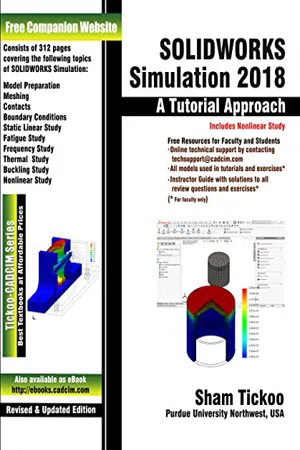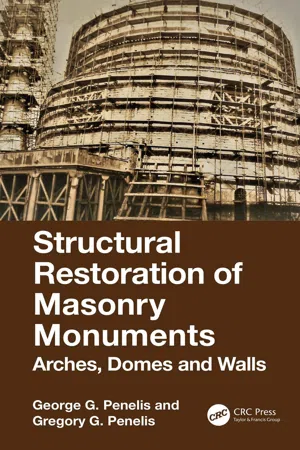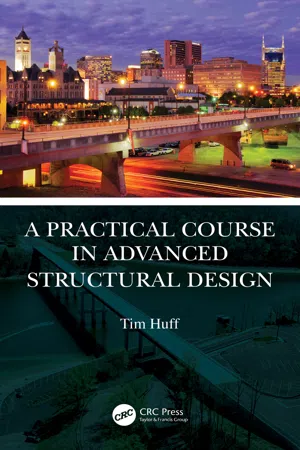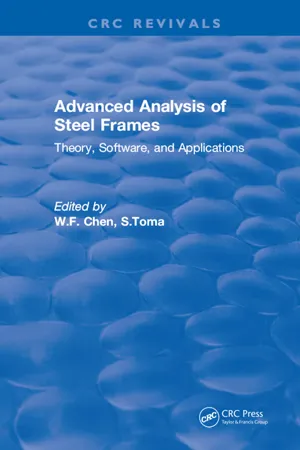Technology & Engineering
Linear Static Analysis
Linear static analysis is a method used in engineering to predict the behavior of structures and components under various loading conditions. It involves analyzing the response of a system to applied loads without considering the effects of time or dynamic forces. This approach is valuable for assessing the strength, stability, and deflection of mechanical and structural systems.
Written by Perlego with AI-assistance
Related key terms
Related key terms
1 of 4
Related key terms
1 of 3
4 Key excerpts on "Linear Static Analysis"
- eBook - ePub
- Prof. Sham Tickoo(Author)
- 2018(Publication Date)
- CADCIM Technologies(Publisher)
Chapter 4Linear Static Study Learning Objectives After completing this chapter, you will be able to: • Perform linear static structural study • Apply boundary conditions • Apply different types of constraints • Apply different types of loads • Generate the result of a studyIntroductionIn this chapter, you will learn about linear static structural analysis problems. In this type of analysis, load or field conditions do not vary with time. Linear Static Analysis is a type of structural analysis and is used to determines the displacements, stresses, strains, and forces in structures or components caused by loads.Linear Static AnalysisWhen loads are applied to a body, the effect of loads is transmitted throughout the body, causing it to undergo deformation. The external loads induce internal forces and reactions to keep the body in a state of equilibrium. Linear Static Analysis is used to calculate displacements, strains, stresses, and reaction forces under the effect of applied loads in equilibrium state.Assumptions of Static Analysis• Loads are applied slowly and gradually.• Loads remain constant (time-invariant) after reaching their maximum value.• Relation between loads and induced responses is linear.• Hook’s law is applicable.• All material properties such as Young’s modulus and Poisson’s ratio remain constant throughout the study.• Loads must be constant in magnitude, direction, and distribution.Tutorials Tutorial 1In this tutorial, you will download c04_tut01 file (bracket model) and analyze the effect of loads. Refer to Figure 4-1 for the given boundary conditions. Consider that the bracket is of Alloy Steel (SS) material and its back face is fixed. You need to determine the von Mises stresses under the load of 5 N. You can download this model from www.cadcim.com - eBook - ePub
Structural Restoration of Masonry Monuments
Arches, Domes and Walls
- George Penelis, Gregory Penelis(Authors)
- 2020(Publication Date)
- CRC Press(Publisher)
Subsection 7.6.2 of this chapter where contemporary trends on masonry mechanics will be presented.7.4 Linear elastic analysis and design
Linear elastic analysis and design is the reference method for almost all design codes in effect for conventional new buildings and to a degree for existing ones too. It may be applied to 1D, 2D and 3D structures for- Static loading and
- Dynamic loading.
- A modal response spectrum analysis
- A static equivalent elastic analysis
- A time-history elastic analysis.
It should be noted that linear elastic analysis allows the separation of analysis from design, meaning that the outcome of analysis is subsequently used for the design of the various cross sections in bending and shear.The main principles on which the linear elastic analysis is based are the following:- The principle of equilibrium condition
- The compatibility of deformations expressed by Bernoulli concept of linear distribution of deformations on any cross section in case of 1D systems
- The assumption of linear constitutive law of material, either in tension or in compression.
All the above principles are expressed by linear equations (Figure 7.22 ), and as a result, the principles ofFigure 7.22 Relations between the basic quantities in structural mechanics. (Courtesy: Vrouwenvelder, A. (2003). The plastic behaviour and the calculations of beams and frames subjected to bending . Technical University Delft, faculty of civil engineering and geosciences Delft, Holland.)- Analogy
- Superposition and
- Separation of design from the analysis
are the main characteristics of the method. All the above advantages have established this method as the basic tool in the hands of the structural engineer for the analysis and design of any type of structure and for all types of materials. Even conventional contemporary masonry buildings, according to Eurocodes, are analysed using linear elastic methods, while the design or resistance verification of the structural elements which are masonry walls, is carried out with the assumption of cracked cross sections in the region under tension (see Chapter 3 - eBook - ePub
- Tim Huff(Author)
- 2021(Publication Date)
- CRC Press(Publisher)
2 Analysis Techniques for the Structural EngineerStatic structural analysis by any of the following methods may be accomplished. The method appropriate for a particular problem depends on the expected level of structural response. Nonlinear effects may be broadly categorized as (a) geometric and (b) material. Geometric nonlinearity refers to P Δ and Pδ effects, while material nonlinearity refers to strains beyond the yield point. P Δ effects refer to moment and deflection amplification which occur when compression member ends experience relative translation. Pδ effects refer to moment and deflection amplification which occur when no member end relative translation exists, but transverse loads between member ends exist in compression members.- First-Order Elastic Analysis : neglects all nonlinearities and is typically a good indicator of service load conditions.
- Second-Order Elastic Analysis : P Δ and Pδ effects are included, but no material nonlinearity is incorporated.
- First-Order Inelastic Analysis: Equilibrium is established on the undeformed structure and material nonlinearity is included.
- Second-Order Inelastic Analysis : Equilibrium is established on the deformed structure and material nonlinearity is included.
2.1 First-Order Elastic Structural Analysis
A first-order structural analysis is the most basic form of structural analysis studied in undergraduate structural mechanics courses. Equilibrium is established on the undeformed structure in a first-order analysis. No straining beyond the yield point is accounted for in elastic analysis. - eBook - ePub
Advanced Analysis of Steel Frames
Theory, Software, and Applications
- W.F. Chen(Author)
- 2018(Publication Date)
- CRC Press(Publisher)
1: Trends Toward Advanced AnalysisJ. Y. Richard Liew, Department of Civil Engineering, National University of Singapore, SingaporeW. F. Chen, School of Civil Engineering, Purdue University, West Lafayette, Indiana1.1 IntroductionSince the publication of the two-volume book on Theory of Beam-Columns (Chen and Atsuta, 1976 and 1977), and the subsequent books and monograph related to Stability Design of Frames (Chen and Lui, 1986 and 1991; SSRC, 1992), our understanding of certain aspects of the behavior and design of steel members and frames has increased considerably and many extensions and advancements have been made during the past 10 years.The advent of limit-states specifications has resulted in more explicit and more rational consideration of the combined effects of inelasticity and stability at maximum strength levels. Since limit-states design is based directly on factored loads and limits of resistance, it is expected that structural systems and their members will behave nonlinearly before their capacity is reached. Of course, the most direct approach for structural design is to model all the significant nonlinear effects in the analysis. However, until recently, rigorous consideration of system as well as member strength and stability in the analysis of large-scale structural system were not feasible and practical. As a result, contemporary specification provisions have been based primarily on simpler methods of analysis and member interaction equations which account approximately for the interaction of strength and stability between the member and structural system.Recently, the advancement in computer hardware, particularly in the computing and graphics performance of personal computers and workstations, is making advanced methods of analysis more and more feasible for design use. This advancement has made it possible for the engineer to adopt the limit-states design philosophy in a wider perspective. Advanced analysis techniques hold the promise of more realistic prediction of load effects and overall structural performance, and therefore in certain cases, yield greater economic and more uniform safety. The two task groups in the U.S. — the American Institute of Steel Construction (AISC) Technical Committee 117 on Inelastic Analysis and Design and the Structural Stability Research Council (SSRC) Task Group 29 on Second-Order Inelastic Analysis for Frame Design
Index pages curate the most relevant extracts from our library of academic textbooks. They’ve been created using an in-house natural language model (NLM), each adding context and meaning to key research topics.
Explore more topic indexes
Explore more topic indexes
1 of 6
Explore more topic indexes
1 of 4



